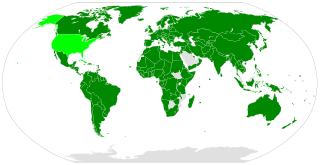 W
WThe International Covenant on Economic, Social and Cultural Rights (ICESCR) is a multilateral treaty adopted by the United Nations General Assembly on 16 December 1966 through GA. Resolution 2200A (XXI), and came in force from 3 January 1976. It commits its parties to work toward the granting of economic, social, and cultural rights (ESCR) to the Non-Self-Governing and Trust Territories and individuals, including labour rights and the right to health, the right to education, and the right to an adequate standard of living. As of July 2020, the Covenant has 171 parties. A further four countries, including the United States, have signed but not ratified the Covenant.
 W
WThe European Cultural Convention is an international Council of Europe's treaty to strengthen, deepen and further develop a European Culture, by using local culture as a starting point. Setting common goals and a plan of action to reach an integrated European society, celebrating universal values, rights and diversity. The Convention contributes to joint action by encouraging cultural activities of European interest.
 W
WThe Hague Convention for the Protection of Cultural Property in the Event of Armed Conflict is the first international treaty that focuses exclusively on the protection of cultural property in armed conflict. It was signed at The Hague, Netherlands, on 14 May 1954 and entered into force on 7 August 1956. As of September 2018, it has been ratified by 133 states.
 W
WA World Heritage Site is a landmark or area with legal protection by an international convention administered by the United Nations Educational, Scientific and Cultural Organization (UNESCO). World Heritage Sites are designated by UNESCO for having cultural, historical, scientific or other form of significance. The sites are judged to contain "cultural and natural heritage around the world considered to be of outstanding value to humanity". To be selected, a World Heritage Site must be a somehow unique landmark which is geographically and historically identifiable and has special cultural or physical significance. For example, World Heritage Sites might be ancient ruins or historical structures, buildings, cities, deserts, forests, islands, lakes, monuments, mountains, or wilderness areas. A World Heritage Site may signify a remarkable accomplishment of humanity, and serve as evidence of our intellectual history on the planet, or it might be a place of great natural beauty. As of July 2021, a total of 1,154 World Heritage Sites exist across 167 countries. With 58 selected areas, Italy is the country with the most sites on the list.
 W
WReshaping Cultural Policies is a report series published by UNESCO which monitors the implementation of the UNESCO Convention on the Protection and Promotion of the Diversity of Cultural Expressions (2005). The 2005 UNESCO Convention encourages its 146 parties to introduce policies for culture within a global context and commitment to protect and promote the diversity of cultural expressions. The second and most recent report (2018) subtitled “Advancing Creativity for Development” follows the first report (2015) with the subtitle “A Decade Promoting the Diversity of Cultural Expressions for Development”.
 W
WThe Convention for the Safeguarding of the Intangible Cultural Heritage is a UNESCO treaty adopted by the UNESCO General Conference on 17 October 2003.
 W
WThe International Organization of Turkic Culture is an international cultural organization of countries with Turkic populations, speaking languages belonging to the Turkic language family. Other than being an abbreviation of the former official name Türk Kültür ve Sanatları Ortak Yönetimi, Türksoy is also a compound noun in Turkish, made up of the words Türk (Turkic) and soy (ancestry).
 W
WThe United Nations Educational, Scientific and Cultural Organization (UNESCO) is a specialised agency of the United Nations (UN) aimed at promoting world peace and security through international cooperation in education, the arts, the sciences, and culture. It has 193 member states and 11 associate members, as well as partners in the non-governmental, intergovernmental, and private sector. Headquartered at the World Heritage Centre in Paris, France, UNESCO has 53 regional field offices and 199 national commissions that facilitate its global mandate.
 W
WThe UNESCO 1970 Convention on the Means of Prohibiting and Preventing the Illicit Import, Export and Transfer of Ownership of Cultural Property is an international treaty. The treaty, signed to combat the illegal trade in cultural items, was signed on 14 November 1970, and came into effect on 24 April 1972. As of August 2021, 141 states have ratified the treaty.
 W
WUNIDROIT Convention on Stolen or Illegally Exported Cultural Objects is the international treaty on the subject of cultural property protection. It attempts to strengthen the main weaknesses of the 1970 UNESCO Convention on the Means of Prohibiting and Preventing the Illicit Import, Export and Transfer of Ownership of Cultural Property. The UNIDROIT Convention seeks to fight the illicit trafficking of cultural property by modifying the buyer's behaviour, obliging him/her to check the legitimacy of their purchase.